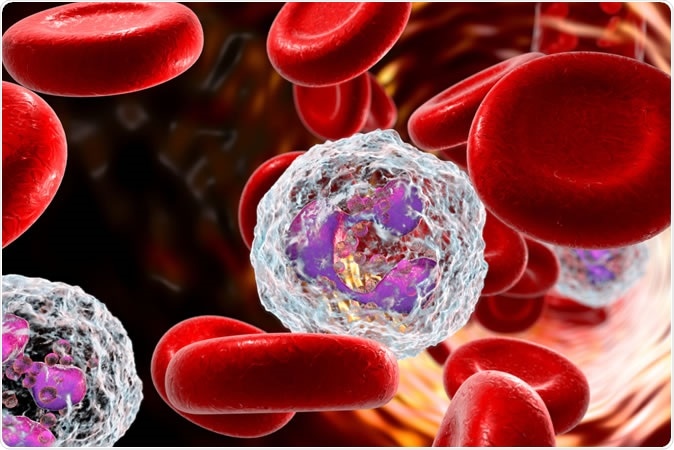Neutrophils are the most abundant component of white cells in blood at 50% to 70%, and are part of the body’s innate immune response, the first defense against microbial intruders. They are thus crucial to controlling infections and eliminating the organisms from the body. When they are exposed to bacterial antigens, they move towards the site, following the trace rather like a bloodhound smelling out the target. This is called chemotaxis - attraction towards bacterial chemicals.

Neutrophil in blood, a white blood cell, 3D illustratio Credit: Kateryna Kon / Shutterstock
Pseudomonas is a Gram-negative organism known for its ability to cause blood infection, pneumonia, urinary infections and other infections in the abdomen. Prior research showed that vapor from e-cigarettes led to reduced killing of these organisms by neutrophils isolated from healthy volunteers.
Vaping – not a safe alternative
E-cigarettes have become a topic of hot controversy, with some people arguing their safety vis-à-vis conventional cigarettes, and others pointing out the almost complete lack of knowledge regarding the safety of inhaled chemicals in e-cigarette smoke, and their physiological effects. Evidence is mounting that shows that E-cigarettes may harm the immune system in the host, though all the mechanisms have not been fully elucidated so far. Their use has been linked to acute eosinophilic pneumonia, lipoid pneumonia, hypersensitivity, asthma, bronchitis, reduced mucociliary clearance of the airways, severe acute lung injury and acute respiratory distress syndrome – severely affecting their image as safe and trendy alternatives to smoking.
The study and its findings
The researchers used commercial vaping liquids and a commonly used vaping device to expose batches of neutrophils in culture to fresh puffs of e-cigarette vapor. They also injected Pseudomonas into healthy mice, exposed them to e-cigarette smoke over the long term and examined neutrophil migration as well as bacterial load.
Neutrophils in culture
The researchers found a 4-fold reduction in chemotaxis in human neutrophils exposed to e-cigarette vapor. Normally, their attraction to Gram-negative bacteria occurs in response to the cell wall component f-Met-Leu-Phe.
The neutrophils also showed increased membrane rigidity and less polarization mediated by F-actin, a cytoskeletal molecule, which forms the leading edge of the moving cell. Both these changes affect the cell’s ability to move freely.
They were also partially disarmed by e-cigarette smoke, which reduced reactive oxygen species (ROS) production within the immune cells by 48%. ROS are at the heart of neutrophil attack by what biologists call the neutrophil extracellular trap (NET). These fascinating antibacterial weapons are structures created from DNA strands coated with sticky proteins or peptides that fight microbes.
The researchers assessed NET production quantitatively, and found that when exposed to e-cigarette vapor, it went down by 3.5 times, mainly, it appears in response to propylene glycol in the vaping liquid. These effects appear to be independent of nicotine since it is seen in neutrophils exposed to pure propylene glycol vapor and to a mixture of propylene glycol and glycerine as well as to a similar mixture also containing nicotine. Alternative mechanisms of NET production remain intact, however.
Still another toxic effect was the lower rate of phagocytosis in neutrophils, the process by which these immune cells engulf bacterial particles. This showed a striking reduction to just over half the original value. Previous studies have shown that macrophages are also unable to phagocytose bacteria effectively.
Neutrophils in infected mice
The researchers also examined how neutrophils behaved in an animal model, with mice exposed long-term (for one hour each day, over one month) to e-cigarette smoke and infection with Gram-negative bacteria. They found that fewer neutrophils in these animals migrated into body spaces that contained infectious organisms, and there was therefore a higher concentration of the bacterium Pseudomonas. Their RNA sequencing studies on lung tissue from these animals also show that endothelial cells may be impacted by the e-cigarette vapor, such that they have a lower production of proteins that stimulate the passage of leukocytes out of the blood vessel into the infected site.
Conclusion
The study strongly suggests that e-cigarette use dampens the immune response very significantly, and predisposes users to slow weak immune defenses against invasive bacterial infections. It adds to the proof that like tobacco smoking and BPA, e-cigarette vapor plays a role in altering host defenses via its action on neutrophils. People who vape may be putting themselves at risk of increased numbers of harmful bacteria in their bodies, as well as impaired neutrophil immunity to move into infected sites and kill the bacteria. The outcome may be increased vulnerability to infections as well as more serious infection.
Flavoring chemicals in vaping liquids may have an even stronger effect. Moreover, while acute exposure by neutrophils directly to this vapor results in the inability to fight infection effectively, systemic exposure through the blood could promote inflammation that increases NET production.
Journal reference:
E-cigarette use increases susceptibility to bacterial infection by impairment of human 1 neutrophil chemotaxis, phagocytosis and NET formation. Ross Corridena, Alexander Moshensky, Christine M. Bojanowski, Angela Meier, Jason Chiena, Ryan K. Nelson, and Laura E. Crotty Alexander. American Journal of Physiology – Cell, 2019. www.physiology.org/journal/ajpcell (203.040.096.254) on November 14, 2019.